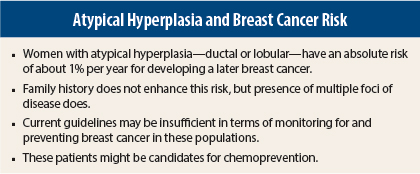Women with atypical hyperplasia have an absolute risk of about 1% per year for developing breast cancer—a level of risk that has been underappreciated. Not enough is being done to protect these women, according to Lynn C. Hartmann, MD, Professor of Oncology at the Mayo Clinic in Rochester, Minnesota.
At the 2014 Breast Cancer Symposium, Dr. Hartmann noted that approximately 10% of the 1.3 million benign breast biopsies performed annually in the United States are found to have atypical hyperplasia, making this benign lesion about twice as common as ductal carcinoma in situ. This points to a large population that deserves better risk management,
she said.
Fairly Common Condition
Atypical hyperplasia comprises ductal and lobular subtypes, which occur with similar frequency in the population and carry similar risks for subsequent breast cancer.
In an effort to better understand atypical hyperplasia and to define its associated risks, Dr. Hartmann led a study of 698 women biopsied at the Mayo Clinic between 1967 and 2001 and followed over time.1 At a mean follow-up of 12.5 years, 143 developed breast cancer, translating into an approximate fourfold relative risk for both subtypes, vs the general population.
For both atypical ductal and lobular hyperplasia, ipsilateral cancer was twice as common as contralateral tumors, and most (80%) were invasive ductal cancers. The ipsilateral breast is at especially high risk for breast cancer within 5 years of diagnosis, and long-term risk is elevated in both breasts.1
Conventional Risk Stratification Difficult
Conventional risk determination is not very helpful in the atypia population, including family history, she indicated. In the Mayo Clinic cohort, patients with a positive family history (weak or strong) were no more likely to develop cancer than those with no family history (P = .23). According to Dr. Hartmann, this makes biologic sense.
“In displaying the phenotype of atypia, the breast tissue has already integrated various exogenous and endogenous risk exposures, including family history,” she pointed out.
The Gail model and the Tyrer-Cuzick model are also not useful in predicting individual risk. “We compared Gail model scores for our patients with atypia who developed breast cancer and those who did not and found the scores to be completely superimposable,” she reported.
Within the Mayo Clinic cohort, the number of women with atypia who developed breast cancer was 1.7 times more than the Gail model predicted (P < .001), indicating that the Gail model significantly underestimates breast cancer risk in this population.2 The Tyrer-Cuzick model, on the other hand, significantly overestimated the risk and did not accurately distinguish, on an individual level, between women who developed invasive breast cancer and those who did not.3
“These models are based on epidemiologic risk factors, such as family history. Such risks have driven the development of atypical hyperplasia and don’t serve to further stratify risk when the phenotype of atypia is present. I would not suggest using these models in this population,” she said.
Risk Stratification Is Possible
It is possible, however, to stratify risk according to the number of atypical foci in the pathology specimen. In the Mayo Clinic cohort, the number of atypical foci was linearly associated with progressive relative risk. Relative risks were 3.19 for women with one focus of disease, 5.53 for those with two foci, and 7.61 for those with three or more.
“It’s like staging cancer: the more there is, the higher the aggressiveness factor. It’s similar with atypical hyperplasia,” she said.
Putting this information together with other published risk information can be more helpful clinically, as it is not focused on relative risk, which can be confusing to women, but rather, on absolute risk.
Dr. Hartmann described a risk model that incorporates time since biopsy and the number of foci of disease, resulting in a cumulative incidence of breast cancer out to 25 years. At 15 years, for example, the model predicts the risk of breast cancer at 14% for women with one focus of atypia, 23% for those with two foci, and 34% for those with three or more.
Dr. Hartmann and her colleagues will soon be publishing the full set of these data, the model, and their recommendations.
“The most important message is that the cumulative risk of breast cancer [in women with atypical hyperplasia] is about 1% per year, and this is higher than most people have previously appreciated,” she said. “If you have information on the number of foci, you can further stratify women into significantly different risk levels. In our model, in women with multiple foci, we are seeing quite a high cumulative risk of breast cancer.”
Not Enough Being Done
“We are not doing enough for the more than 100,000 women diagnosed with atypical hyperplasia a year,” Dr. Hartmann maintained.
She pointed out that women with atypical hyperplasia currently do not qualify under several sets of guidelines for screening by magnetic resonance imaging, largely because accurate risk data are lacking. Guidelines by the American Cancer Society, National Comprehensive Cancer Network, and American College of Radiology focus on hereditary risk.
“Most of the published guidelines state only relative risk data for atypical hyperplasia or a lower lifetime risk, such as 15%, which does not qualify them for screening magnetic resonance imaging. Their high cumulative risk is not yet recognized,” she pointed out.
Chemoprevention is an effective means of reducing risk, based on four pharmacologic intervention trials that also included women with atypia. Women with atypia actually achieved higher relative risk reductions than the high-risk population in general—41% to 70% vs 38%. This makes sense, she added, because the large majority of atypical hyperplasias are positive for the estrogen receptor, and 90% of breast cancers that develop after prior atypia are also estrogen receptor–positive.
In 2013, the ASCO guidelines for breast cancer risk reduction were updated to recommend that chemoprevention be discussed as an option, and the U.S. Preventive Services Task Force acknowledged a moderate net benefit with tamoxifen/raloxifene in reducing breast cancer risk in high-risk women. The problem is that chemoprevention is used very infrequently in all high-risk subsets, Dr. Hartmann noted.
“Many women are reluctant to use these drugs because of a fear of side effects, but physicians are also reluctant to prescribe them, especially family physicians, who report being unfamiliar with the agents and their side-effect profiles,” she offered.
“Chemoprevention in this particular high-risk population should be encouraged,” she said. For optimal decision-making, patients and physicians need information about the absolute risk of developing breast cancer, the absolute gain from chemoprevention, and the absolute risk of serious side effects. “Relative risk information does not help us care for these women,” she added. ■
Disclosure: Dr. Hartmann reported no potential conflicts of interest.
References
1. Hartmann LC, Radisky DC, Frost MH, et al: Understanding the premalignant potential of atypical hyperplasia through its natural history: A longitudinal cohort study. Cancer Prev Res 7:211-217, 2014.
2. Pankratz VS, Hartmann LC, Degnim AC, et al: Assessment of the accuracy of the Gail model in women with atypical hyperplasia. J Clin Oncol 26:5374-5379, 2008.
3. Boughey JC, Hartmann LC, Anderson SS, et al: Evaluation of the Tyrer-Cuzick (International Breast Cancer Intervention Study) model for breast cancer risk prediction in women with atypical hyperplasia. J Clin Oncol 28:3591-3596, 2010.



